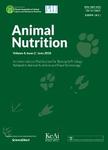The adaptive strategies of yaks to live in the Asian highlands
The adaptive strategies of yaks to live in the Asian highlands作者机构:State Key Laboratory of Grassland and Agro-EcosystemsInternational Centre for Tibetan Plateau Ecosystem ManagementCollege of EcologyLanzhou UniversityLanzhou 730000China State Key Laboratory of Grassland Agro-ecosystemsCollege of Pastoral Agriculture Science and TechnologyLanzhou UniversityLanzhou 730020China School of Public HealthLanzhou UniversityLanzhou 730000China Desert Animal Adaptations and HusbandryWyler Department of Dryland AgricultureBlaustein Institutes for Desert ResearchBen-Gurion University of NegevBeer Sheva 8410500Israel
出 版 物:《Animal Nutrition》 (动物营养(英文版))
年 卷 期:2022年第9卷第2期
页 面:249-258页
核心收录:
基 金:the National Natural Science Foundation of China(32072757 and U21A20250)
主 题:Yak Adaptive strategy Grazing behaviour Nutrient metabolism Gastrointestinal microbiome
摘 要:The yak(Bos grunniens),an indigenous herbivore raised at altitudes between 3,000 and 5,000 m above sea level,is closely linked to more than 40 ethnic communities and plays a vital role in the ecological stability,livelihood security,socio-economic development,and ethnic cultural traditions in the Asian *** provide the highlanders with meat,milk,fibres,leather and dung(fuel).They are also used as pack animals to transport goods,for travel and ploughing,and are important in many religious and traditional *** Asian highlands are known for an extremely,harsh environment,namely low air temperature and oxygen content and high ultraviolet light and *** availability fluctuates greatly,with sparse pasture of poor quality over the long seven-month cold *** longterm natural and artificial selections,yaks have adapted excellently to the harsh conditions:1)by genomics,with positively selected genes involved in hypoxia response and energy metabolism;2)anatomically,including a short tongue with a weak sense of taste,and large lung and heart;3)physiologically,by insensitivity to hypoxic pulmonary vasoconstriction,maintaining foetal haemoglobin throughout life,and low heart rate and heat production in the cold season;4)behaviourlly,by efficient grazing and selecting forbs with high nutritional contents;5)by low nitrogen and energy requirements for maintenance and low methane emission and nitrogen excretion,namely,‘Low-Carbon’and‘Nitrogen-Saving’traits;6)by harboring unique rumen microbiota with a distinct maturation pattern,that has coevolved with host *** review aims to provide an overview of the comprehensive adaptive strategies of the yak to the severe conditions of the highlands.A better understanding of these strategies that yaks employ to adapt to the harsh environment could be used in improving their production,breeding and management,and gaining benefits in ecosystem service and a more resilient livelihood to climate chang



